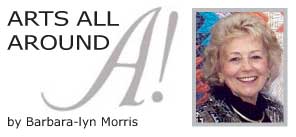

North Carolina has an ATTITUDE about that state's artists, one I envy for our artists in Tennessee and Virginia. Two examples illustrate actions of support in North Carolina that emanate from that attitude. One is private and the other is a combination of public and private support.
Recently I drove from Richmond to Atlanta via I-85, much of which runs through North Carolina. About half an hour after crossing the state line into North Carolina, I was attracted by large words on a roadside billboard: Art of the State. I risked stopping to photograph it and then took a slight detour to the advertised Cedar Creek Gallery.
Cedar Creek's brochure begins: "Expect to be overwhelmed...." I was. In the woods off Exit 186 near Creedmoor, about 30 minutes from Raleigh, an assortment of rustic buildings -- old tobacco barns -- have been converted into an expansive arts center. Some barns were moved intact from former tobacco farms in the region; others were disassembled and then reconstructed at Cedar Creek. Together, they house artist workshops and an amazing collection of work by more than 800 artists, many of them from North Carolina, as designated by a blue sticker.
Touted as "the largest selection of quality handmade crafts in the Southeast," Cedar Creek is owned by Pat Oakley. She and her late husband, Sid, started the business 40 years ago. A potter couple, they wanted to sell their own work and support "the collective energy of the work of America's most accomplished craftspersons." Gallery manager Jennifer Dolan explained that the Oakley daughter, Lisa, is involved with the business today. Determined not to be a potter like her parents because it was "too hot and dirty," she became a glassblower, which is "hotter and dirtier," chuckled Dolan. In addition to glassblower Lisa, there are three potters and a fiber artist in residence at Cedar Creek.
Guest artists also share their skills with visitors. The day I was there, Julie Olson was demonstrating at a potter's wheel. As she turned the clay, Olson told her story of moving to North Carolina from California "a few decades ago" and loving North Carolina where she "feels supported." Olson is one of more than 150 artists represented in Cedar Creek's acclaimed teapot exhibit: National Teapot Show VII, June 6-September 7.
I enjoyed seeing Olson's whimsical stoneware houses. Many gave me a smile, such as the house with ball and chain called "House Arrest." Collectively, they caused me to pay attention to the forms in which we live and work, as I continued the long drive to Atlanta.
On the return trip, I took a break in downtown Greensboro, primarily because I had read about its 2008 bicentennial celebration. While there are several independent and college-related art galleries and small museums in Greensboro, it was the Greensboro Cultural Center at Festival Park that most intrigued me.
The Center is a striking architectural structure created by the adaptive reuse of four structures, including the old headquarters of the local newspaper. Prominently identified on a plaque in the large atrium as "A City of Greensboro Facility," the 121,000 square-foot center contains rent-free space to 15 visual and performing arts organizations, as well as extensive exhibition space for four North Carolina-focused galleries:
--- African American Atelier, Inc. showcasing a wide array of talent;
--- Center for Visual Artists (formerly the Greensboro Artists League) promoting primarily emerging artists;
--- Green Hill Center for North Carolina Art focusing on accomplished artists with "close ties to the state" (currently, more than 100 portraits of and by North Carolinians are featured in its large gallery space);
--- Guilford Native American Art Gallery showing both traditional and contemporary art.
Each venue includes a gift shop and space for meetings and workshops. Green Hill offers a large inviting hands-on space for children to work in a wide variety of art forms, from weaving on a seven-foot loom to digging in the clay garden and painting in studios. Several entities offer classes for children and adults with a large summer camp program. The largest allocations for space go to dance and music. Jeanie Duncan, President and CEO of the United Arts Council of Greensboro (UAC), explained, "We are booming between three and nine (PM) with families and children packed in here for instruction."
Duncan described the 18-year-old venue with varied programming as a "successful public/private partnership." Initially a $5 million capital campaign supported the renovation. Since the early 1990s, programming at the Greensboro Cultural Center has been sustained with support from two primary sources:
--- an annual gift-in-kind (now estimated to be $600,000) from the city, which owns and maintains the facility;
--- an annual $1.5 million spring fundraising drive by the UAC, from which direct grants and services are provided. (Duncan said, "We function as a peer agency with the United Way, which conducts a fall campaign.")
Imagine if every municipality and its citizens had such will to support "the art of the state."
If You Go...Cedar Creek Gallery is open daily from 10 a.m. to 6 p.m., except Thanksgiving and Christmas, at 1150 Fleming Road, Creedmoor, N.C., 919-528-1041; Greensboro Cultural Center is downtown at N. Davie Street, open Tuesday-Saturday 10 a.m.-5 p.m. (7 p.m. Wednesdays) and Sundays 2-5 p.m., with certain holiday closings, 336-373-7523. Call ahead to confirm.